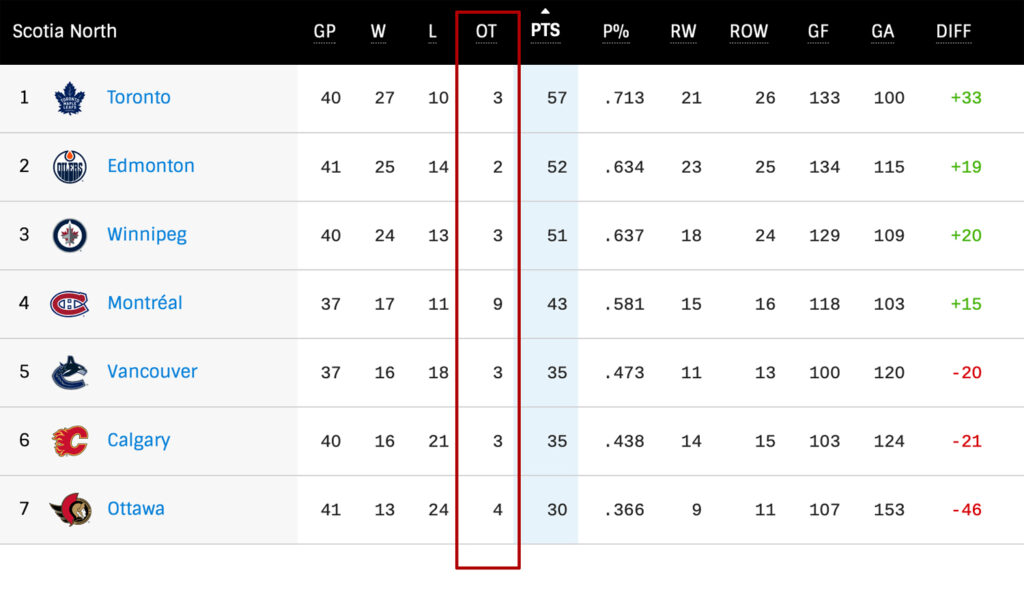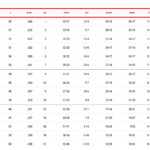If you’re looking at the NHL standings, there are three columns that specifically relate to a team’s record.
Those columns are collectively abbreviated as W-L-OTL or sometimes W-L-OT.
The first two letters refer to Wins (W) and Losses (L).
In this case, the losses (L) refer particularly to regulation losses. These are losses that teams sustain at the end of 60 minutes.
However, quite a few games finish regulation time with the score remaining tied.
In today’s NHL, each game must have a declared winner and loser.
So, to settle these tie games, teams face each other in overtime and possibly in a shootout.
The team that eventually wins the game will have their Win totals increase by one.
Meanwhile, the losing team will see an increase to their OTL column.
What does OTL mean in hockey?
OTL stands for overtime and shootout losses in the NHL standings. It is the total amount of losses experienced by teams beyond regulation time during the regular season. Teams earn 1 point in the standings when they lose in overtime or shootout.
As a note, teams do not earn any points (0) when they lose a game in regulation time.
How can you differentiate between overtime and shootout losses in OTL?
While staring at the OTL column, you might be wondering how you can distinguish between overtime and shootout losses.
If you knew the results of each game in memory, that would make it easier.
But let’s be real, not everyone has photogenic memory. Especially when it comes to remembering specific outcomes of NHL games.
But there is a quick way to figure it out.
You need the help of the S/O column in the NHL standings, also known as the “Record in Games Decided by Shootout”.
The value recorded under this column for each team states their Wins and Losses respectively (ex: 4-1, 2-2, etc.).
Automatically, you know how many shootout losses a team has accumulated from the S/O stat.
The remaining OTL losses can then attributed to losses endured in overtime.
Is there any difference between an overtime and shootout loss in OTL?
Yes, but it does not directly affect the team that accumulated those losses. Rather, it can have an impact in the standings for the opposing team who beat them.
We know that teams earn 2 points for every win, regardless if they stem from regulation, overtime or shootout.
However, when two teams are tied in the standings, the number of regulation wins and overtime wins are of greater importance than shootout wins.
This is reflected in the tie-breaking procedures #2 and #3, found at the bottom of the NHL standings page. (source)
These relate to the RW (Regulation Wins) and ROW (Regulation plus Overtime Wins) columns in the standings.
RW refers to the total of regulation wins accumulated by each team. Wins in this column are of the highest importance.
But since RW does not directly correlate in any shape or form to overtime and shootout losses, we’ll leave it aside from this discussion.
If you want to learn more in detail about the RW column, make sure to check out my blog post here.
However, ROW does have direct a connection to OTL (overtime and shootout losses).
The wins a team earns in overtime are tallied toward the ROW total. They do not include wins accumulated in the shootout.
As a result, a team that is equal in points (PTS), equal in Regulation Wins (RW total) but has more Regulation plus Overtime Wins (ROW total) will rank higher in the NHL standings.
For more on the ROW column, make sure to check out my blog post here.
When was OTL introduced in the NHL Standings?
OTL was first introduced in the 1999-2000 season. However, back then, the shootout did not exist, and the acronym referred only to Overtime Losses.
Overtime Losses would earn each team a single point in the standings.
The reason for introducing the OTL column is because rivaling teams would play more cautiously in the overtime period in prior years.
That’s because if a team were to lose in overtime, they wouldn’t any earn points. Both teams would rather secure the point from a tie game rather than risk losing and earn nothing.
Those points could make the difference in clinching a playoff spot or not.
So, in the end, the NHL decided that every team that reaches overtime would earn a point regardless of the overtime outcome.
That way, teams would take more risks to win games in overtime, making the game more exciting to fans.
By the 2005-06 season, the NHL introduced shootouts and the OTL column was redefined as overtime and shootout losses.
The league wanted a clear winner and loser for every game but didn’t want endless overtime periods, as in the playoffs.
So, following a 5-minute overtime period, teams would face each other in a 3-round shootout. If the game is still tied after 3 shooters on each side, it continues round by round until a winner is declared.
For more information about the length and structure of overtime and shootouts, make sure to check out my blog post here.






